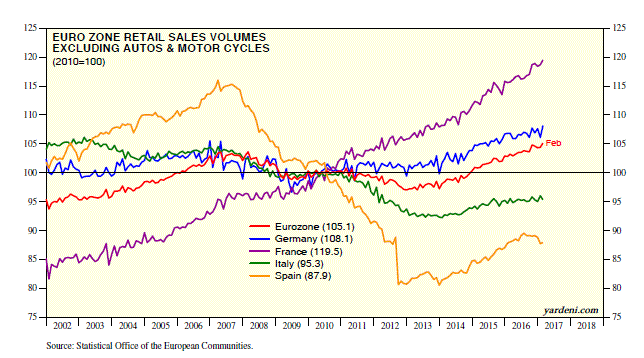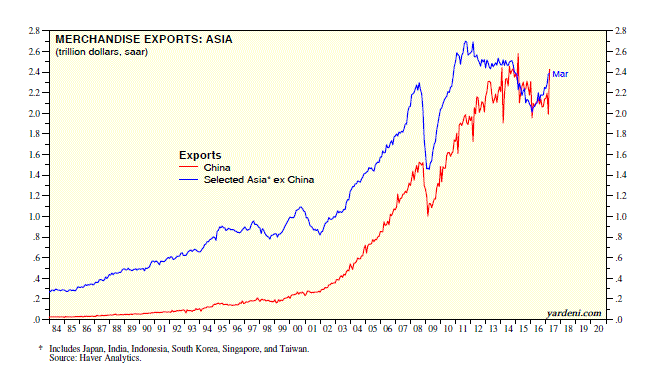Since late last year, I’ve liked what I’ve been seeing abroad, especially in emerging economies. The latest batch of data out of China was certainly surprisingly strong, though that isn’t surprising given that the country’s central planners still command the economy over there as they see fit.
The EU’s economy also has impressed me. Like everyone else, I’ve been concerned about the region’s political drift toward anti-EU populism that could lead to the destabilizing disintegration of the EU and/or the Eurozone. However, that risk seems to have dissipated significantly given the recent successes of the establishment parties that remain in power in Spain and the Netherlands. Italy continues to be ungovernable—so what else is new?—but still committed to the EU.
What about France? Following last weekend’s first-round presidential election, I expect that pro-EU centrist Emmanuel Macron, who was a member of the Socialist Party from 2006-2009, will beat National Front leader Marine Le Pen during the second-round contest scheduled for May 7. As they say in French, “Plus les choses changent, plus elles restent les mêmes.”
Let’s take a tour of the latest developments around the world, shall we?
(1) Commodity prices. The CRB raw industrials spot price index dropped last week to the lowest level since January 9. However, it’s down only 2.4% from its recent high on March 17. It is still up 26.2% from its most recent low near the end of 2015. In the big picture, this index remains on a solid uptrend. However, it is a bit odd to see this recent weakness coinciding with all the better-than-expected data coming out of China last week.
(2) PMIs & production. There shouldn’t be much more downside in commodity prices given the strength in April’s flash M-PMIs for Germany and France. The composite PMI for Germany edged down to 56.3 from 57.1 last month. That’s still a relatively high level, with Germany’s M-PMI remaining very elevated at 58.2 versus 58.3 during March. France’s C-PMI jumped to 57.4 from 56.8, with lots of strength in the M-PMI (55.1) and NM-PMI (57.7). Japan’s M-PMI also remained solid at 52.8 this month.
On the other hand, the flash M-PMI for the US continued to edge down from a recent high of 55.0 during January to 52.8 this month. The NM-PMI has also come down from a recent high of 55.6 during January to 52.5 this month.
Nevertheless, these are all solid readings for the US. The average of the business conditions indexes from the NY and Philly Fed district surveys declined to 13.6 this month from a recent high of 31.0 during February, as Debbie discusses below. Looks like some of the “animal spirits” unleashed by Trump’s election may be going back into their cages!
On yet another hand, industrial production indexes remain on uptrends in the US, Canada, the Eurozone, and Japan. Even Brazil’s output seems to have bottomed, while Mexico’s remains stalled at a record high despite Trumps tough talk on US trade with our southern neighbor. Most impressive is that industrial production among the 34 members of the OECD rose 1.2% y/y during January after having stalled during 2015 and the first half of 2016. It is now almost at the previous record high during January 2008.
(3) Retail and auto sales. In the Eurozone, the volume of retail sales (excluding motor vehicles) rose 0.7% m/m and 1.8% y/y during February to a new record high. Both French and German shoppers are doing lots of shopping, with their volume indexes up 2.8% and 1.6% y/y, respectively, at record highs. The Italians and Spaniards are lagging far behind. New passenger car registrations in the EU jumped 1.2% m/m and 6.0% y/y during March, using the 12-month sum.
(4) Inflation. Both actual and expected inflation rates have edged down recently, suggesting that the global economy isn’t overheating. Expected inflation implied by the yield spread between the US Treasury 10-year bond and TIPS fell from a recent high of 2.08% on January 27 to 1.84% at the end of last week.
The headline CPI inflation rates, on a y/y basis, moved down in March in the US (from 2.7% to 2.4%) and the Eurozone (from 2.0% to 1.5%), and was little changed in China (from 0.8% to 0.9%). The core CPI inflation rates also have ticked down in the US (from 2.2% to 2.0%) and the Eurozone (from 0.9% to 0.7%), and edged up in China (from 1.8% to 2.0%).
(5) Forward revenues and earnings growth. Interestingly, there has been a significant increase since early last year in analysts’ consensus expectations for short-term revenues growth over the year ahead, from 2.3% to 6.3% in mid-April. Even more impressive is the rebound in year-ahead short-term earnings growth from the most recent low of 6.2% early last year to 13.7% now. Long-term earnings growth, over the next five years at an annual rate, is up to 12.5%, the highest since September 2011.
(6) Global trade. Global trade indicators are looking more buoyant. The Baltic Dry Index is up 86% y/y through mid-April. Over the past 12 months through March, US West Coast ports’ outbound container traffic is up 6.0% y/y to the highest level of activity since January 2015. Actual exports data coming out of Asia are especially strong. March data are available in dollars for India (up 28.3% y/y), Indonesia (23.2), China (17.4), Singapore (15.8), Taiwan (14.0) South Korea (13.5), and Japan (10.3). Altogether, they are up 16.4% y/y, and 15.4% excluding China.
No wonder that the iShares MSCI Emerging Markets (NYSE:EEM) stock price index (in local currency) is up 29.0% from its low early last year. The index’s forward earnings (in local currency) is up 8.6% over this period. Analysts’ consensus expected short-term earnings growth over the year ahead for this index was back up to 16.0% in early April compared to the most recent low of 4.5% early last year. The index remains relatively cheap with a forward P/E of 12.2.
(7) IMF forecast. The IMF’s economists are raising their expectations for global economic growth. Since nearly the start of the latest global economic expansion, they were too optimistic and have had to lower their forecasts. Last week, they nudged up the IMF’s forecast for world growth this year a tenth of a percentage point to 3.5%, which will be the fastest rate in five years if they are right. Next year’s growth rate is expected to be 3.6%, according to the IMF’s latest World Economic Outlook. Global growth was 3.1% last year.
The so-called advanced economies, which grew 1.7% last year, are expected to expand by 2.0% during both 2017 and 2018. The emerging and developing economies, which grew 4.1% last year, are predicted to grow by 4.5% this year and 4.8% next year. The top concern among the IMF’s economists is trade protectionism, specifically an “inward shift in policies, including toward protectionism, with lower global growth caused by reduced trade and cross-border investment flows.”


